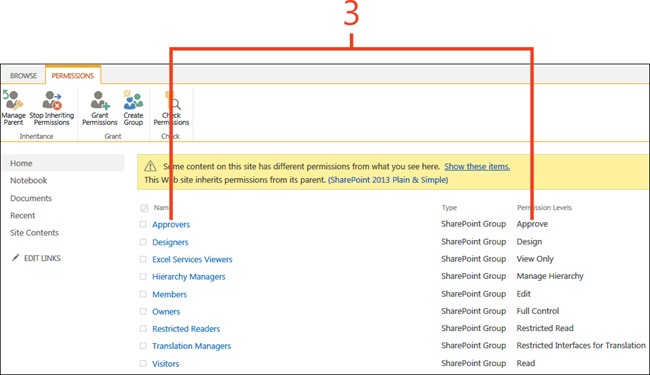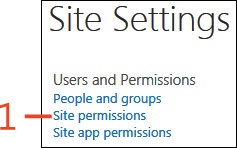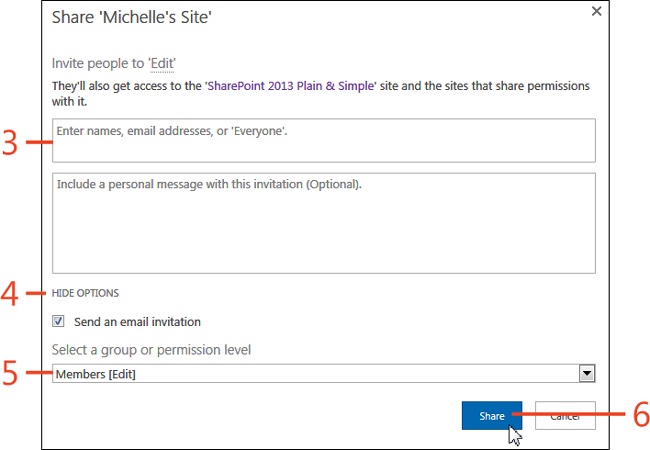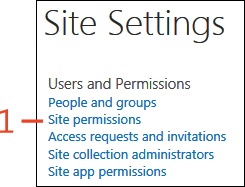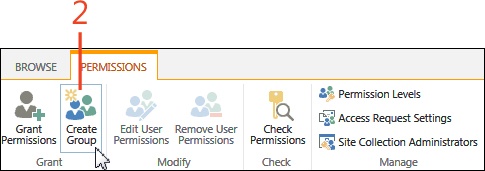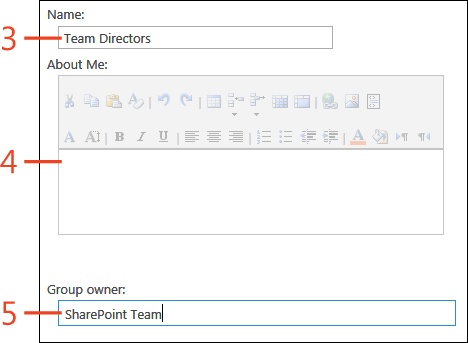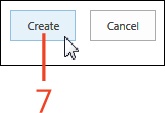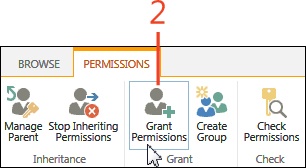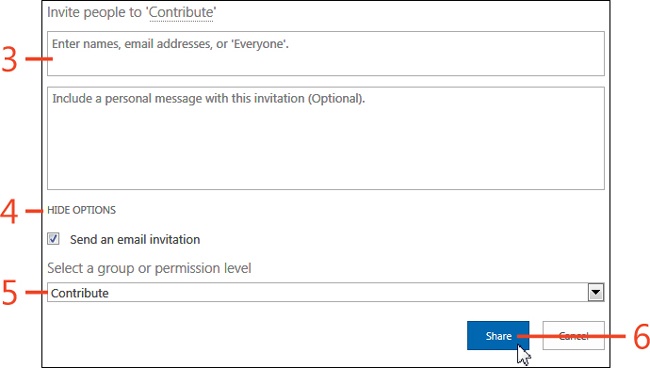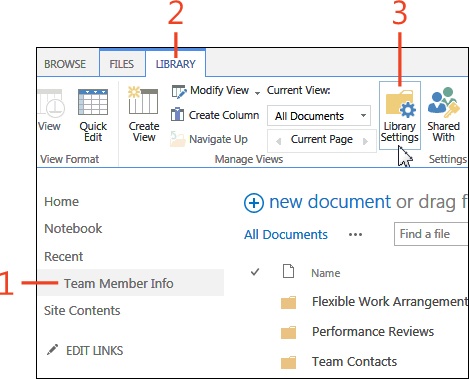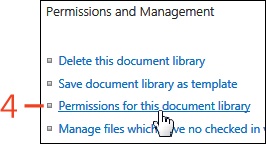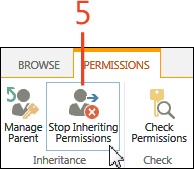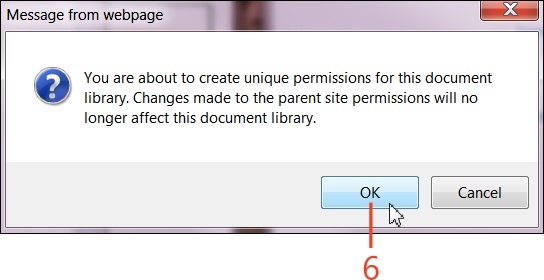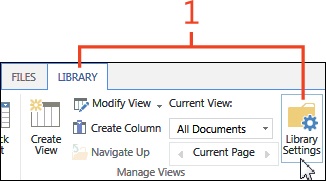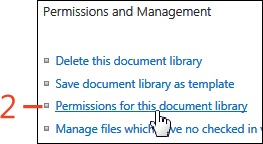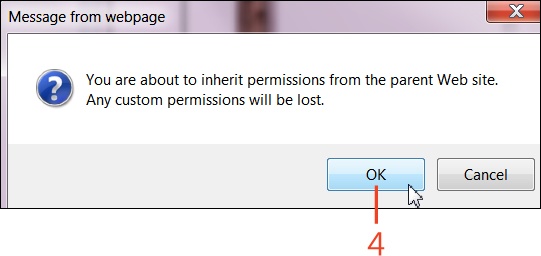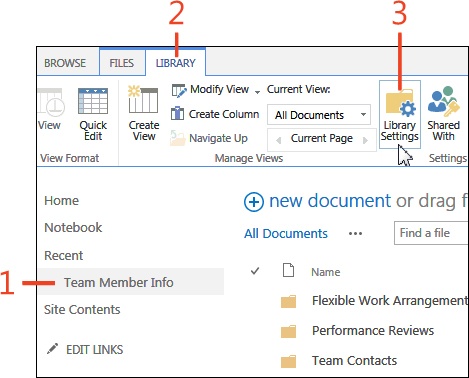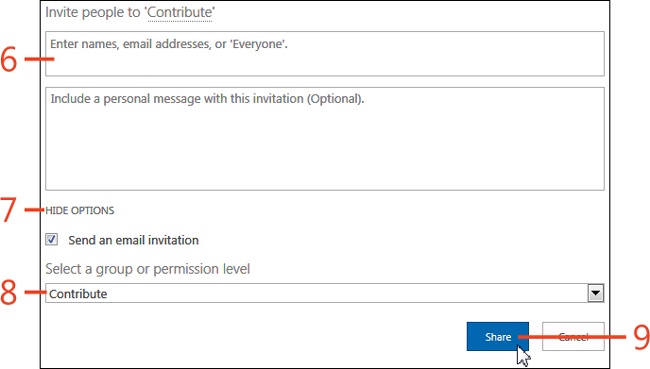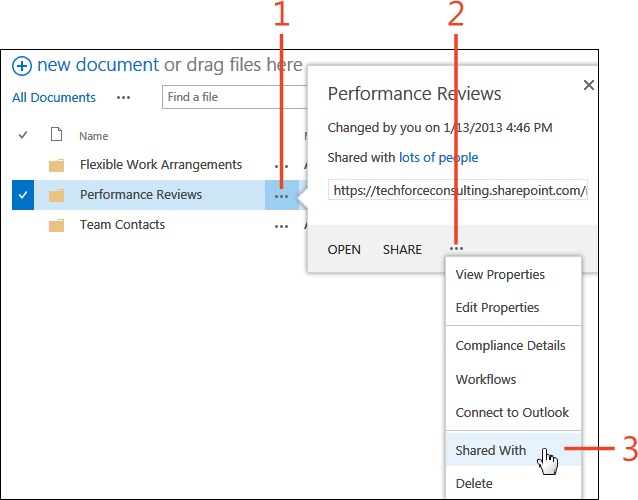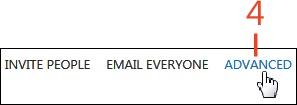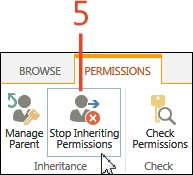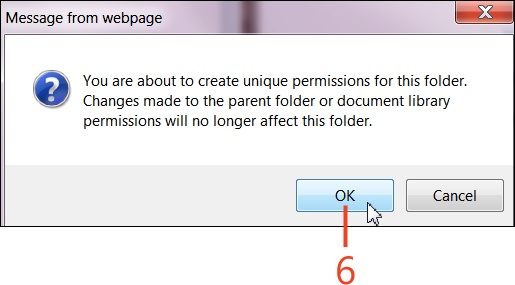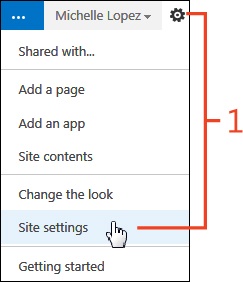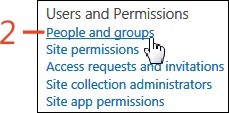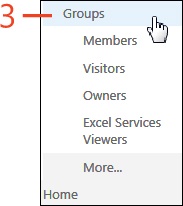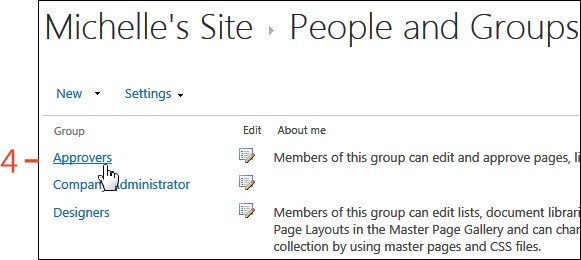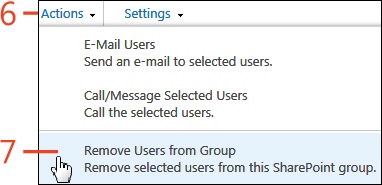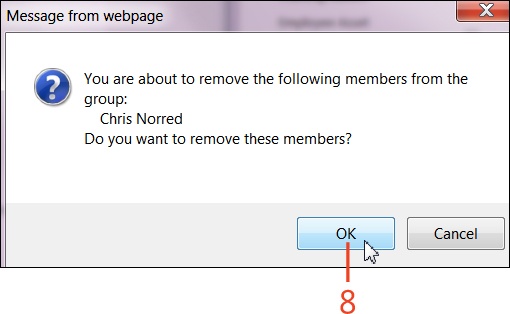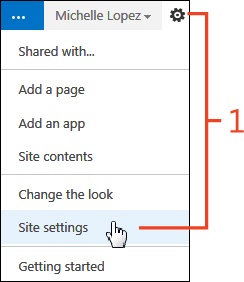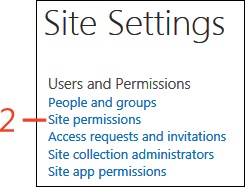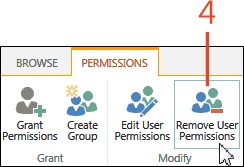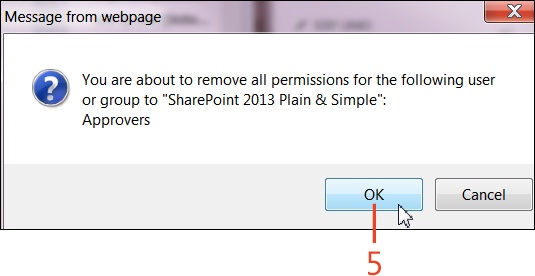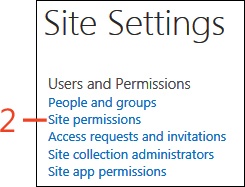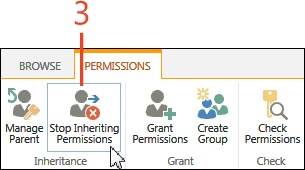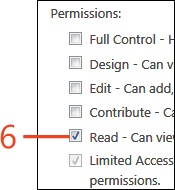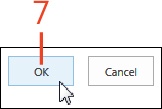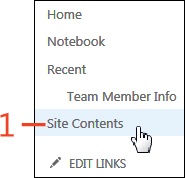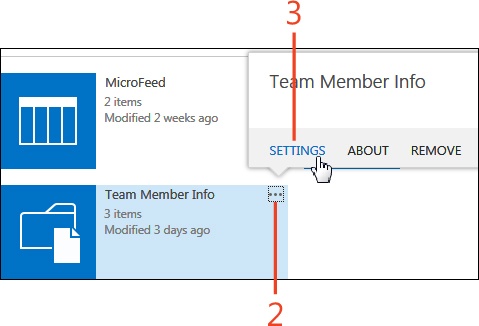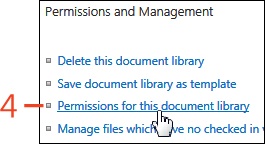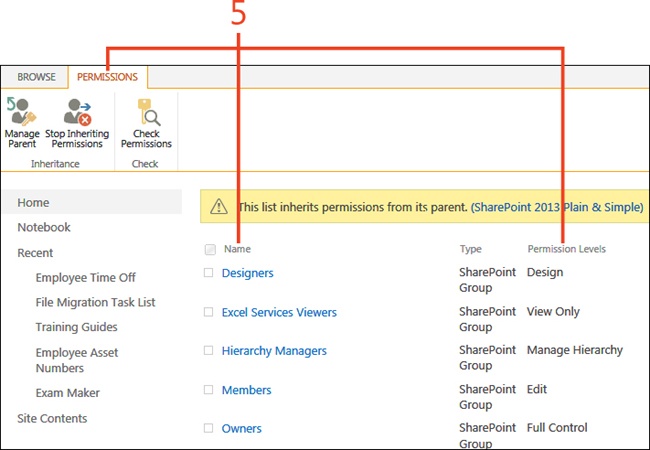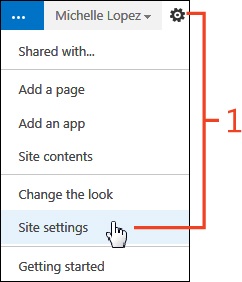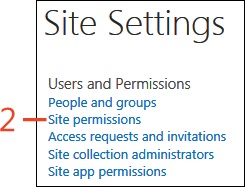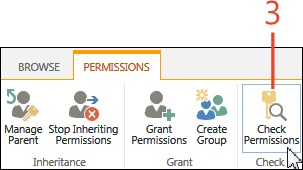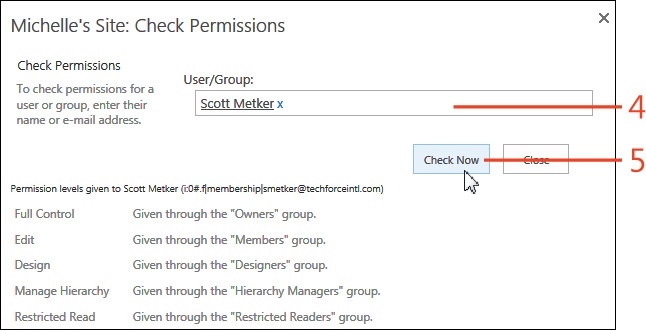 14. Security within SharePoint 2013
by Michelle Lopez Johnathan Lightfoot and Scott Metker
Microsoft SharePoint 2013 Plain & Simple
14. Security within SharePoint 2013
by Michelle Lopez Johnathan Lightfoot and Scott Metker
Microsoft SharePoint 2013 Plain & Simple
- Dedication
- Special Upgrade Offer
- Acknowledgments
- 1. About this book
- 2. What’s new and improved in SharePoint 2013
- Creating a new site
- Customizing the interface
- Using the Office Store
- Creating an asset library
- Adding a thumbnail to a video
- Using SkyDrive Pro
- Using the timeline feature for tasks
- Mentioning a colleague feature
- Expanding My Tasks settings
- Previewing search documents
- Using the Community Site template
- Creating badges
- Creating an eDiscovery Center
- Using Visual Designer for workflows within SharePoint Designer
- 3. Getting started with SharePoint sites
- Understanding sites
- Creating a SharePoint site from a template
- Locating content on a site
- Changing your site’s title, description, and logo
- Changing the look and feel of a site
- Changing the navigation tree view settings
- Editing the Quick Launch bar on a nonpublishing site
- Editing the Top Link bar on a nonpublishing site
- Editing publishing site navigation
- Saving a site as a template
- 4. Organizing and managing information
- 5. List and library essentials
- Using your apps
- Creating and deleting lists
- Adding and editing list items
- Deleting and restoring list items
- Creating list columns
- Editing and deleting list columns
- Using list and column validation rules
- Sorting and filtering lists
- Creating and selecting a list view
- Sorting or filtering a list view
- Organizing items by using folders
- 6. Working with documents
- Managing documents with a document library
- Customizing document templates
- Uploading multiple documents
- Requiring and displaying document check out
- Checking documents in and out
- Configuring documents with document IDs
- Using document IDs
- Moving documents
- Copying or sharing documents
- Configuring document sets on a site
- Configuring document sets on a document library
- 7. Working with media
- 8. Using SkyDrive Pro
- Accessing your SkyDrive Pro account
- Saving files to SkyDrive Pro
- Saving files to be accessible only to you
- Sharing SkyDrive Pro files
- Following SkyDrive Pro documents
- Locating followed documents by using the newsfeed
- Locating followed documents by using SkyDrive Pro
- Synchronizing SkyDrive Pro to your local computer
- Discontinuing sync between SkyDrive Pro and your local device
- 9. Using information management policies
- Introduction to information management policies
- Information management policy inheritance
- Accessing site content type information management policies
- Accessing list information management policies
- Creating content type retention policies on a library
- Setting library or folder-based retention schedules
- Creating auditing policies
- Viewing an audit report
- 10. Organizing people and work
- Creating a project schedule by using a tasks list
- Adding tasks
- Viewing tasks in a Gantt Chart
- Adding multiple tasks and subtasks
- Creating a calendar list
- Scheduling events on the calendar
- Using the issue tracking list
- Creating a discussion board
- Participating in a discussion
- Rating discussions
- Connecting a discussion to Microsoft Outlook
- Synchronizing project tasks with Microsoft Project
- 11. Using Web Parts
- 12. Using SharePoint with Office 2013
- 13. Collaborating with blogs
- 14. Security within SharePoint 2013
- 15. Using personal sites and social networking
- 16. Searching for information
- Creating a Search Center
- Searching from a Search Center
- Preparing your site for search
- Searching site content
- Using search refinement
- Previewing search results in Search Center
- Using advanced search
- Working with search alerts
- Setting your search preferences
- Promoting search results
- Excluding site content
- Excluding document libraries and lists from search
- Excluding site columns from search
- Maintaining search configurations
- 17. Community portals and sites
- Creating a community site site collection
- Creating a community site subsite
- Adding moderators to community sites
- Adding users to community sites
- Managing your community settings
- Working with categories
- Working with badges
- Assigning badges to members
- Enabling site-wide reputation tracking
- Viewing badges and reputation scores for a member
- Creating and editing discussions
- Replying to a discussion
- Searching for discussions
- Tracking discussions in progress
- Managing replies
- Moderating discussions
- Reviewing posts submitted for moderation
- 18. Automating tasks with workflows
- Associating workflows with lists
- Associating workflows with content types
- Starting workflows on documents
- Checking the status of a running workflow
- Creating a list workflow in SharePoint Designer
- Editing workflows
- Introducing Microsoft Visio integration with SharePoint workflows
- Switching to the visual designer
- Creating workflows in Visio 2013
- Importing Visio workflows into SharePoint Designer
- 19. SharePoint and eDiscovery
- A. About the authors
- Index
- About the Authors
- Special Upgrade Offer
- Copyright
Chapter 14. Security within SharePoint 2013
Securing an organization’s information is crucial. Protecting organizational content is a key component to the success of that security.
Microsoft SharePoint 2013 provides proficient security tools to ensure that teams are completely confident that their content is available only to the users to whom they’ve granted access. Using the SharePoint security model, you can apply access privileges at an overall level such as the site collection, down to an individual level like a single document—not to mention all the levels in between (sites, pages, or lists and libraries).
Understanding SharePoint security
You can only access SharePoint 2013 if a SharePoint administrator or site owner grants you permission. You can grant permissions to groups of people or to individuals. SharePoint administrators can grant access to Active Directory groups, or Windows network groups, as well.
It is recommended to add individuals to SharePoint groups and then provide access to those groups, rather than directly to individuals. A SharePoint group is a collection of individuals (up to 5,000), and it is much more convenient to manage the applied security settings to a group than to manage individual users.
View site permissions
On the Home page, click the Settings button (the small gear icon next to the name of the logged-on user). On the menu that appears, click Site Settings.
On the Site Settings page, in the Users And Permissions section, click Site Permissions.
On the Permissions page, view the permission levels assigned to each group on the site.
Adding people to groups
A new site can be created to use the same permissions as the parent site or to use unique permissions. Upon creation of a new site with unique permissions, SharePoint 2013 automatically creates three groups: Visitor, Member, and Owner. New groups can be created, and unused groups can be deleted.
Permissions then need to be assigned to groups for them to actually be of use. SharePoint administrators can use permission levels to control what groups or individuals can do within SharePoint. Thirty-three selectable permissions can be mixed and matched in different combinations to define thousands of permission levels.
Permission levels determine what type of activities that group can perform on a site, page, list, library, item, or document. Upon creation of a new team site, SharePoint automatically creates seven permission levels:
Permission level | Definition |
Full Control | Users have full control of a site to add, delete, approve, move, and create new sites. |
Design | Users can view, add, delete, approve, and customize a SharePoint site. |
Edit | Users can add, edit, and delete lists. They can also view, add, update, and delete list items and documents. |
Contribute | Users can view, add, update, and delete list items and documents. |
Read | Users can view pages and list items. They can also can download document copies. |
Limited Access | User can view specific lists, document libraries, list items, folders, or documents when given permission. |
View Only | Similar to the Read permission level, but users cannot download items. |
Add people to existing groups
On the Site Settings page, in the Users And Permissions section, click Site Permissions.
On the Permissions page, click the Permissions tab and then, in the Grant group, click Grant Permissions.
In the Share dialog box, in the designated text box, enter names, email addresses, or the word “Everyone”.
Click the Hide Options button.
In the Select A Group Or Permission Level list box, select a group name.
Click Share.
Creating groups
Customizing SharePoint groups makes it possible for your organization to effectively grant access to only the users it specifies. When you create a group, you can name it, assign it a permission level, and add people to it.
Create a group
On the Site Settings page, in the Users And Permissions section, click Site Permissions.
On the Permissions page, click the Permissions tab and then, in the Grant group, click Create Group.
On the Create Group page, in the Name text box, enter a name for the group.
In the About Me text box, enter a description.
Assign a group owner to the group.
In the Give Group Permission To This Site section, select a check box corresponding to the permission level that you want to assign to the group.
Click Create.
Granting permissions to an individual
By assigning people to SharePoint 2013 groups, you can see what permissions an individual has and assign those same permissions to someone else simply by adding that person to the same group. Occasionally, however, you might need to assign permissions directly to a user to grant access to a site or its individual items.
Grant permissions to an individual
On the Site Settings page, in the Users And Permissions section, click Site Permissions.
On the Permissions tab, in the Grant group, click Grant Permissions.
In the Share dialog box, in the designated text box, enter names, email addresses, or the word “Everyone”.
Click the Show Options button.
In the Select A Group Or Permission Level list box, select a permission level.
Click Share.
Breaking permission inheritance
By default, all children objects (sites, pages, lists, libraries) inherit their permissions from their parent site. Permissions for objects cascade from the parent to the child. For instance, a subsite inherits the permissions of its parent site. A library inherits the permissions of the site in which it is created, and a document inherits the permissions of the library to which it is uploaded. If you want to stop this inheritance and customize permissions, you’ll need to break inheritance.
Perhaps you have a site with team information for everyone on your team. By default, everyone who has access to a team library can see the documents in that library. Still, you might want to restrict the Performance Reviews folder to only allow managers to access it. In this case, you would break the inheritance from the parent library so that only the Managers group can see that particular folder.
Break inheritance
Select the list or library with which you want to work (for this example, we’ll work with a library).
On the ribbon, click the Library tab.
In the Settings group, click Library Settings.
On the Library Settings page, in the Permissions And Management section, click Permissions For This Document Library.
On the Permissions tab, in the Inheritance group, click Stop Inheriting Permissions.
In the pop-up message box that asks you to confirm the change, click OK.
Inherit parent permissions
Select the list or library with which you want to work (for this example, we’ll work with a library). On the ribbon, click the Library tab and then, in the Settings group, click Library Settings.
On the Library Settings page, in the Permissions And Management group, click Permissions For This Document Library.
On the ribbon, click the Permissions tab and then, in the Inheritance group, click Delete Unique Permissions.
In the pop-up message box that asks you to confirm the change, click OK.
Granting access to lists, libraries, and individual items
When not inheriting permissions from its parent, SharePoint 2013 allows owners to apply unique security at the site collection level, the site level, the library or list level, and to items within a library or list. You might want to grant your department Read access to your site but only allow certain team members to edit documents within the site. SharePoint flexibly accommodates these needs.
Grant access to a list or library
Select the list or library with which you want to work (for this example, we’ll work with a library).
On the ribbon, click the Library tab.
In the Settings group, click Library Settings.
On the Library Settings page, in the Permissions And Management group, click Permissions For This Document Library.
On the Permissions tab, in the Grant group, click Grant Permissions.
In the Share dialog box, in the designated text box, enter names, email addresses, or the word “Everyone”.
Click the Show Options button.
In the Select A Permission Level list box, select a permission level.
Click Share.
Grant access to individual items
Click the drop-down ellipsis to the right of an item in a list or library. (Hover over the item to view the pointing hand.)
In the lower-right corner of the Properties box that opens, click the drop-down ellipsis. (Hover over the item to view the pointing hand).
On the menu that appears, click Shared With.
On the Shared With page, click Advanced.
On the Permissions tab, in the Inheritance group, click Stop Inheriting Permissions.
In the pop-up message box that asks you to confirm the change, click OK.
Back on the ribbon, click Grant Permissions.
In the Share dialog box, in the designated text box, enter names, email addresses, or the word “Everyone”.
Click the Show Options button.
In the Select A Permission Level list box, select a permission level.
Click Share.
Removing security
Logically, if you’ll be granting access to SharePoint 2013, you’ll be removing access, as well. Removing users from items or groups involves the same steps as adding users. You’ll begin to realize the convenience of managing users in groups as opposed to individually. Removing users from a group can be done in one location instead of each location where they’ve been added separately.
Remove a user from a group
On the Home page, click the Settings button (the small gear icon next to the name of the logged-on user). On the menu that appears, click Site Settings.
On the Site Settings page, in the Users And Permissions section, click People And Groups.
On the Quick Launch bar, click Groups.
Click the name of the group from which you want to remove the user.
Select the check box next to the name of the user whom you want to remove.
Click the Actions drop-down arrow.
On the menu that appears, click Remove Users From Group.
In the pop-up message box that asks you to confirm the change, click OK.
Remove a group’s site permissions
On the Home page, click the Settings button (the small gear icon next to the name of the logged-on user). On the menu that appears, click Site Settings.
On the Site Settings page, in the Users And Permissions section, click Site Permissions.
Select the check box next to the group from which you want to remove site permissions.
On the Permissions tab, in the Modify group, click Remove User Permissions.
In the pop-up message box that asks you to confirm the change, click OK.
Editing permissions
Suppose that a project has completed and you no longer want the team to add or edit the project’s supporting documents. The flexibility of SharePoint 2103 gives you the ability to easily make changes to permission level of an individual or a group.
Edit site permissions for an individual or group
On the Home page, click the Settings button (the small gear icon next to the name of the logged-on user). On the menu that appears, click Site Settings.
On the Site Settings page, in the Users And Permissions section, click Site Permissions.
On the Permissions page, if the site is inheriting permissions, click Stop Inheriting Permissions, and then, in the pop-up message box that asks you to confirm the change, click OK.
Select the check box next to the group or individual for which you want to edit permissions.
Click Edit User Permissions.
Clear the current permissions check box and select a different one.
Click OK.
Checking permissions
It can be easy to lose track of who has access to your sites and libraries. You can use the tools on the SharePoint 2013 ribbon to check what permissions are on an entire site or to view a summary of the permissions assigned to a group or individual.
View permissions on a library or list
On the Quick Launch bar, click Site Contents.
Click the drop-down ellipsis to the right of the library with which you want to work. (Hover over the library for the drop-down indicator to display).
On the menu that appears, click Settings.
On the Library Settings page, in the Permissions And Management group, click Permissions For This Document Library.
On the Permissions tab, review each group name and permission level.
Check permissions for an individual or group
On the Home page, click the Settings button (the small gear icon next to the name of the logged-on user). On the menu that appears, click Site Settings.
On the Site Settings page, in the Users And Permissions section, click Site Permissions.
On the Permissions tab, in the Check group, click Check Permissions.
In the Check Permissions dialog box, in the User/Group text box, enter the name of the person or group.
Click Check Now.
In the Check Permissions dialog box, review the permission level summary.
-
No Comment


